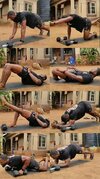Kegel exercises are pelvic floor muscle exercises that involve contracting and relaxing the muscles that support the pelvic organs. These exercises can benefit both men and women by improving bladder control, sexual function, and pelvic floor strength. Here's a detailed guide on how to do them:

1. **Find the right muscles**: To identify your pelvic floor muscles, try to stop your urine flow midstream. The muscles you use to do this are the ones you should be targeting with Kegel exercises. However, it's important not to regularly stop your urine flow during urination, as it can lead to urinary issues.
2. **Empty your bladder**: Before starting the exercises, it's recommended to empty your bladder to avoid any discomfort.
3. **Get into position**: You can perform Kegel exercises in various positions, such as sitting, standing, or lying down. Choose whichever position is most comfortable for you.
4. **Contract your muscles**: Once you're in position, contract your pelvic floor muscles by squeezing them tightly. Focus on lifting them upward rather than squeezing your buttocks or abdominal muscles. Hold the contraction for about 3-5 seconds, making sure to breathe normally during this time.
5. **Relax your muscles**: After holding the contraction, slowly release the muscles and relax for about 3-5 seconds.
6. **Repeat**: Aim to do 10-15 repetitions of the contractions in one session, gradually increasing the number as you become more comfortable with the exercises. Try to do at least three sessions of Kegel exercises each day.
7. **Maintain consistency**: Consistency is key to seeing results with Kegel exercises. It may take several weeks or even months before you notice significant improvements in bladder control or pelvic floor strength.
8. **Avoid overdoing it**: While it's important to be consistent, avoid overdoing Kegel exercises, as this can lead to muscle fatigue or strain. Start with a manageable number of repetitions and gradually increase them over time.
Benefits of Kegel exercises include:
1. **Improved bladder control**: Strengthening the pelvic floor muscles can help prevent or reduce urinary incontinence.
2. **Better sexual function**: Kegel exercises can enhance sexual sensation and orgasm intensity for both men and women.
3. **Prevention of pelvic organ prolapse**: Strengthening the pelvic floor muscles can help support the pelvic organs and reduce the risk of pelvic organ prolapse, where the bladder, uterus, or rectum drops into the vaginal area.
4. **Postpartum recovery**: Kegel exercises can aid in the recovery of pelvic floor muscles weakened during pregnancy and childbirth.
In summary, Kegel exercises are simple yet effective exercises that can be done anywhere and at any time to improve pelvic floor strength and overall health. Consistency and proper technique are key to reaping the benefits of these exercises.

1. **Find the right muscles**: To identify your pelvic floor muscles, try to stop your urine flow midstream. The muscles you use to do this are the ones you should be targeting with Kegel exercises. However, it's important not to regularly stop your urine flow during urination, as it can lead to urinary issues.
2. **Empty your bladder**: Before starting the exercises, it's recommended to empty your bladder to avoid any discomfort.
3. **Get into position**: You can perform Kegel exercises in various positions, such as sitting, standing, or lying down. Choose whichever position is most comfortable for you.
4. **Contract your muscles**: Once you're in position, contract your pelvic floor muscles by squeezing them tightly. Focus on lifting them upward rather than squeezing your buttocks or abdominal muscles. Hold the contraction for about 3-5 seconds, making sure to breathe normally during this time.
5. **Relax your muscles**: After holding the contraction, slowly release the muscles and relax for about 3-5 seconds.
6. **Repeat**: Aim to do 10-15 repetitions of the contractions in one session, gradually increasing the number as you become more comfortable with the exercises. Try to do at least three sessions of Kegel exercises each day.
7. **Maintain consistency**: Consistency is key to seeing results with Kegel exercises. It may take several weeks or even months before you notice significant improvements in bladder control or pelvic floor strength.
8. **Avoid overdoing it**: While it's important to be consistent, avoid overdoing Kegel exercises, as this can lead to muscle fatigue or strain. Start with a manageable number of repetitions and gradually increase them over time.
Benefits of Kegel exercises include:
1. **Improved bladder control**: Strengthening the pelvic floor muscles can help prevent or reduce urinary incontinence.
2. **Better sexual function**: Kegel exercises can enhance sexual sensation and orgasm intensity for both men and women.
3. **Prevention of pelvic organ prolapse**: Strengthening the pelvic floor muscles can help support the pelvic organs and reduce the risk of pelvic organ prolapse, where the bladder, uterus, or rectum drops into the vaginal area.
4. **Postpartum recovery**: Kegel exercises can aid in the recovery of pelvic floor muscles weakened during pregnancy and childbirth.
In summary, Kegel exercises are simple yet effective exercises that can be done anywhere and at any time to improve pelvic floor strength and overall health. Consistency and proper technique are key to reaping the benefits of these exercises.


